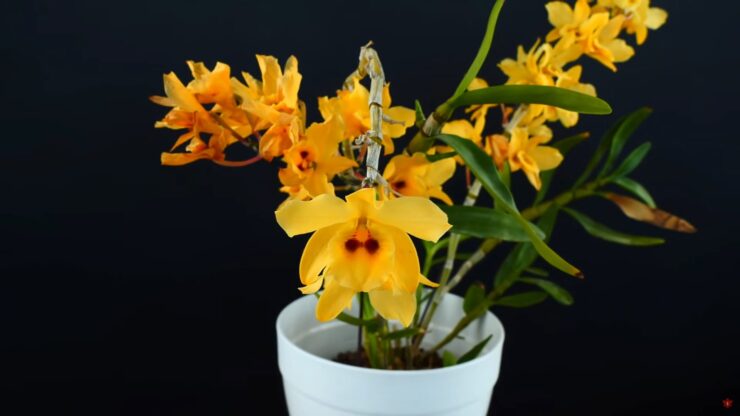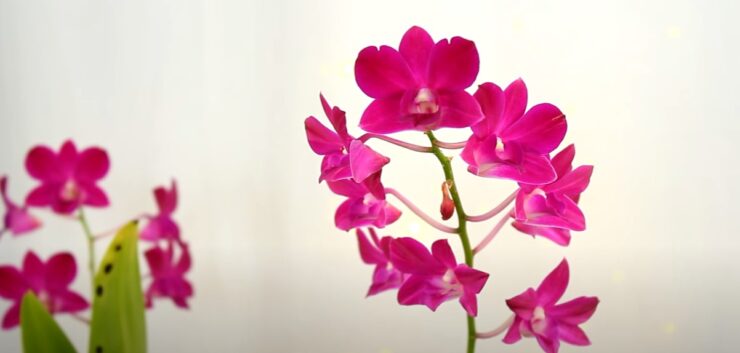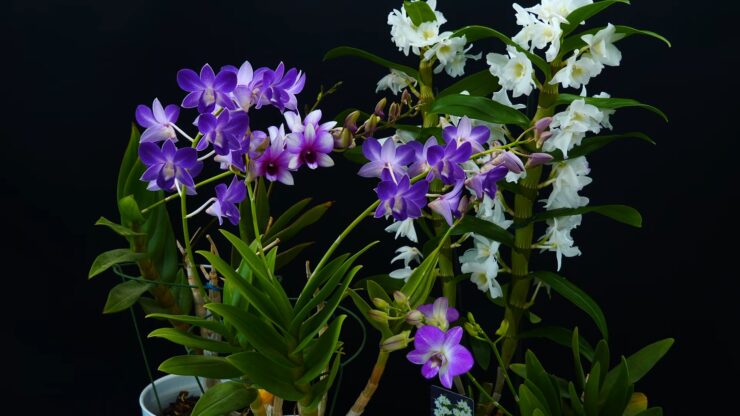In this article, we will delve into the beauty and significance of the January birth orchid, known as the Dendrobium, which holds a special place in the world of flowers and is highly regarded for its stunning appearance and cultural symbolism.
The Dendrobium is a popular choice among orchid enthusiasts due to its delicate, yet striking appearance, with petals that come in a range of colors from white and pink to purple and yellow.
Beyond its beauty, this orchid also carries cultural significance in various parts of the world, with some cultures believing it symbolizes strength, wisdom, and beauty, while others consider it a symbol of purity and innocence.
As we explore more about the January birth-orchid, we will uncover the various meanings and traditions associated with this remarkable flower.
History of the Orchid
The Dendrobium Orchid, which comprises over 200 species, is a large and highly popular group, and is widely known as the easiest to grow. Its growing popularity can be attributed to its versatility, making it ideal for use in gardens, home decor, crafts, lei’s, and floral arrangements, as it showcases big, beautiful blooms in a range of colors.
Originating from regions that span between Japan, New Guinea, Australia, and South-East Asia, including New Zealand, humans have used this orchid in various ways for millions of years.
However, it was officially classified by Swedish botanist Olof Swartz in 1799, who named the genus “Dendrobium,” derived from the Greek words “dendron” meaning tree, and “bios” meaning life, referring to the orchid’s natural growth habit of thriving on trees.
Introduction to United States and Popular Culture
In the 19th century, the floral industry experienced a surge in the handling of orchids, especially in Great Britain, where British agents were dispatched to remote locations to collect various species and transport them back to the country.
Unfortunately, mishandling led to the loss or destruction of several species, leading to a scarcity that resulted in a price hike. However, orchid populations were later replenished through breeding, which produced multiple hybrid breeds that could be mass-produced and sold at an affordable price.
Orchids were initially viewed as a luxury plant due to their rarity and high cost, and they were often associated with royal families in British culture.
Today, there are over 100,000 orchid species in existence, making them highly sought-after by florists, decorators, and enthusiasts alike.
Symbolism and Cultural Significance

Orchids have held significant symbolic meaning in different parts of the world throughout history. For instance, in ancient Greece, orchid roots were used to predict the gender of unborn babies, with a large tuberous root indicating a male child, while a small root indicated a female child.
In Aztec culture, the orchid was believed to imbue strength and power to whoever used it, leading to the creation of tinctures made from white orchids and vanilla for spiritual purposes.
The Japanese also consider orchids to be symbols of strength and fertility, representing perseverance, resilience, and the ability to thrive in adversity.
Overall, orchids are revered for their beauty and cultural significance, making them a favorite among enthusiasts and collectors.
Medicinal Purposes
Orchids have a rich history of use as both medicinal and spiritual aids, long before modern people started cultivating and selling them. These flowers contain various substances with tonic, astringent, analgesic, antipyretic, and anti-inflammatory properties, which have traditionally been used in the treatment of a wide range of ailments.
In particular, orchid flowers, especially the Dendrobium Orchid or the “Bamboo Orchid,” have been a common ingredient in traditional Chinese medicine, where they were utilized to treat conditions such as lung diseases, brutal coughs, kidney diseases, eye diseases, stomach deficiencies, and to nourish the Yin and enhance production of body fluids.
Even today, orchids are still used for medicinal purposes in China, typically in the form of tea.
Fun Facts

- Orchids have no fragrance
- They remove pollutants and toxins from the air
- One of the oldest and largest families of flowering plants. Since varieties of orchids are found all over the world, it’s accepted that orchids were in existence prior to the separation of the continents.
- At the Singapore Botanical Garden, there is a specimen of giant orchid (Grammatophyllum speciosum), also called tiger orchid, which was planted in 1861, shortly after the garden was founded, and is therefore 159 years old.
- The vanilla bean comes from a species of Orchid. The Vanilla Orchid is the only commercially grown and harvested Orchid plant.
- Orchids have the tiniest seeds in the world. A single seedpod can have up to 3 million seeds inside! The seeds are so small they can only be seen under a microscope.
- Orchids take about 5-7 years to bloom once germinated. Plants sold in stores are already decades old! At home, they’re easy to grow and can re-bloom several times a year.
Ways To Use Orchids
As previously stated, Orchids are among the most popular flowers in the world for decorating, events and adding some beauty to really anything.
Dendrobium orchids have many popular uses that take advantage of both the beauty, environment and meaning of these amazing flowers.
Dendrobium Orchids are popular during weddings, especially as corsages. Its stems and delicate blossoms are popularly used in bridal flower arrangements too as it showcases the beauty of the bride. Preferred choices include creamy white as well as pink dendrobium orchids.
Orchid flowers are a powerful symbol of love that endures beyond death, making them a fitting addition to funeral arrangements.
Regardless of the color, Orchids carry a universal message of “I love you now and always” that can be conveyed through casket arrangements, floral sprays, or wreaths to adorn the service.
Apart from funerals, Dendrobium orchids are also an excellent choice for home decor, adding a touch of elegance and a burst of color to any living space.
Gifting an Orchid to a loved one is a thoughtful gesture that symbolizes love and care, providing them with a beautiful and uplifting visual to cherish.
Dendrobium Orchid Care
This gorgeous ornamental houseplant will thrive mostly if kept as an indoor plant, but if you want to treat them as an outdoor plant, make sure it’s in a place where there’s shade or surrounding trees near it.
Great, now we have the important part of the two differences between the Dendrobium Orchids (Shoe.)
So to help with the care requirements, we will refer to the Hard-Cane and Soft-Cane for each one’s requirements.
Lighting
The Hard-cane variety of Dendrobium Orchids thrive in bright, indirect sunlight. It is recommended to place them near an east-facing window where they can enjoy gentle morning sun rays. For those situated near a south-facing window, it is best to provide dappled light to avoid exposing the plant to direct sunlight.
In areas where daylight hours are less than ten, it is important to maximize the amount of light the plant receives without exposing it to direct sunlight, which can be harmful. To achieve this, it is advisable to keep an eye on the sun’s movement throughout the year and adjust the orchid’s placement accordingly.
On the other hand, the Soft-cane variety of Dendrobium Orchids can tolerate more light and prefers bright light during summer and direct sunlight during winter.
However, it is important to limit direct sunlight exposure to only a few hours in the morning and afternoon.
During spring, fall, and winter, it is best to place them near a south-facing window.
In contrast, during summer, it is recommended to move them to an east-facing window to prevent leaf scorching.
Temperature and Humidity
Both the Hard-cane and Soft-cane varieties of Dendrobium Orchids prefer temperatures ranging from 65 to 85 degrees Fahrenheit, with nighttime temperatures not dropping below 54 degrees Fahrenheit. However, during autumn, it is recommended to maintain specific temperatures for Soft-cane Orchids, as this helps stimulate bud and bloom growth.
In terms of humidity, the Hard-cane variety thrives at humidity levels between 50% to 60%, while the Soft-cane variety prefers higher levels of 50% to 70%. To increase humidity levels indoors, one can invest in a humidifier or place a tray filled with pebbles and water near the plant.
This ensures that the orchids have a suitable environment for healthy growth and development.
Air Circulation
Whether you have Hard-cane or Soft-cane Dendrobium Orchids, they need sufficient airflow. Do you live in a poorly ventilated living space? We recommend opening a window or using an oscillating fan to reduce the risk of fungal diseases.
Now, please do not go and set that fan on high or expose them to cold drafts. It will cause bud drops.
Soil
Both the Hard-cane and Soft-cane Dendrobium Orchids thrive in moist soil, but it is important to ensure that the soil dries out between watering.
The best way to determine when to water is by using your finger to monitor the moisture level in the soil.
If the soil feels dry, water the plant until the soil is saturated, allowing the excess water to drain well from the potting medium.
However, it is crucial to avoid leaving the plant standing in water, even though they love humidity.
This helps prevent waterlogging and promotes healthy growth.
Water
Yes, you get a one-way ticket to root rot town and head out to Trash Can City. The frequency of watering also depends on how root-bound it is and the size of the pot. Another excellent tip is to water your plants in the morning.
Then, during autumn and winter, you can slow down the watering. Then, once new buds develop, you can increase your watering again.
Fertilizer
Both the Hard-cane and Soft-cane varieties of Dendrobium Orchids benefit from regular feeding with water-soluble fertilizers specifically formulated for these plants. It is recommended to feed the orchids every two weeks, using half the recommended strength of the fertilizer. This is because Dendrobiums are prone to root burn when exposed to strong fertilizers.
To avoid over-fertilizing, it is advisable to water the plant thoroughly every fourth week to flush out any excess fertilizer from the pot. This ensures that the orchids receive the necessary nutrients for healthy growth without causing harm to their roots.
Another concern to watch out for is a high nitrogen level as it causes excessive green leafy growth, promoting baby plant offshoots (Keikis.) In turn, it will divert the energy for producing more flowers. During October, you can stop feeding as it helps stimulate reblooming.
The same applies to reducing the water and exposing your plant to cooler temperatures where permitted.
You can, however, resume feeding after the flowering is finished.
Potting Mix Tips
Dendrobium Orchids are epiphytic plants that grow on other plants rather than in the ground.
When potted, it is essential to ensure that the soil is well aerated and provides adequate drainage.
A pre-prepared orchid mix or a homemade mix of equal parts of coarse pine bark, husk, and perlite can be used as potting medium.
Propagation
Orchids can be propagated using different methods. Keikis, which are offshoots produced in low-light conditions, can be removed and transplanted when they have grown new leaves and shoots at least a couple of inches long.
The Pseudobulbs Technique involves dividing the rhizomes by severing them between the stem-and-leaf growths found at the base of the mother plant.
The bulbs or rhizomes should be placed in moist sphagnum peat moss in a low-light environment with good ventilation.
Growth Zone
Dendrobium Orchids can be left outside in winter for a few weeks after they have flowered, but temperatures should not fall below 50°F.
These orchids can be grown easily in USDA zones 9 to 12.
Drying Out of the Canes
Underwatering can lead to the canes of Nobile Orchids wilting and drying out.
During the growing season, the soil should be checked for dryness and watered when necessary.
During dormancy in wintertime, the soil can be allowed to dry out.
Common Diseases & Pests
Dendrobium Orchids are hardy foliage plants that are resistant to pests.
Scale is the most common problem, but they can also be affected by mealybugs, fungus gnats, thrips, whitefly, and mites.
Yellow leaves can be caused by underwatering, overwatering, or root rot. It can also be caused by underfeeding, too much light, or sun damage.
Remember to maintain suitable humidity levels for the plant and monitor the potting medium for moisture levels.
FAQs
How Do You Care for Dendrobium After Flowering?
Once your Dendrobium Orchid has finished flowering, it requires specific care to maintain its health and ensure that it blooms again in the future. Here are some tips on how to care for your Dendrobium after flowering:
First, you should cut back the flower stem just above the node where the first flower grew. This helps the plant produce new growth and increases the likelihood of future flowering.
During the plant’s dormant period, which is typically from autumn to spring, you should reduce the frequency of watering and fertilizing. Allow the potting medium to dry out slightly before watering, and fertilize the plant sparingly or not at all.
Dendrobium Orchids require bright but indirect sunlight, so place the plant near an east-facing window or provide shading from direct sunlight. Keep the temperature between 65 to 85 degrees Fahrenheit during the day and above 54 degrees Fahrenheit at night.
If the plant has outgrown its pot or the potting medium has decomposed, repot the plant in fresh medium during the growing season. Additionally, prune dead or damaged roots or pseudobulbs during repotting or as necessary.
By providing the appropriate care, your Dendrobium Orchid will continue to thrive and produce beautiful blooms for years to come.
Why Is My Dendrobium Orchid Not Flowering?
When a Dendrobium Orchid fails to bloom, it can be due to several factors. One common cause is inadequate light. Dendrobium Orchids require bright, indirect sunlight to bloom. Insufficient light can result in no flowers.
Temperature is another important factor. Dendrobium Orchids require specific temperature conditions to bloom. The plant needs to be kept between 65 to 85 degrees Fahrenheit during the day and above 54 degrees Fahrenheit at night.
Overwatering or underwatering can also prevent the plant from blooming. Dendrobium Orchids require moist soil but should not be allowed to sit in standing water. Water the plant when the potting medium feels dry to the touch, and ensure proper drainage.
Lack of nutrients can also impact blooming. Dendrobium Orchids need appropriate nutrients to produce blooms. Fertilize the plant every two weeks during the growing season with a water-soluble fertilizer specifically designed for orchids.
Lastly, some Dendrobium Orchids require a certain level of maturity before they can produce blooms. Give your plant time and proper care, and it may eventually bloom.
Where to Buy Dendrobium?
Dendrobium Orchids can be purchased from a variety of sources, including garden centers, nurseries, and online plant retailers. It’s essential to ensure that the source you’re purchasing from offers healthy, well-cultivated plants.
When purchasing Dendrobium Orchids, choose plants with healthy, green leaves and no signs of discoloration or damage. Look for plants with strong, robust roots that are not brown or mushy.
Consider purchasing from a reputable grower or seller, who can provide information on the plant’s specific care needs and offer advice on how to keep the plant healthy and thriving.
You can also attend plant shows and auctions, where orchid growers often showcase their plants and offer them for sale.
Conclusion
The dendrobium orchid is a beautiful and easy-to-care-for flower that holds special significance for those born in January. Whether you’re an experienced orchid enthusiast or a beginner, the Dendrobium orchid is a great choice for adding natural beauty to your home or garden.
If you like this article read more here about December and October birth orchids.
